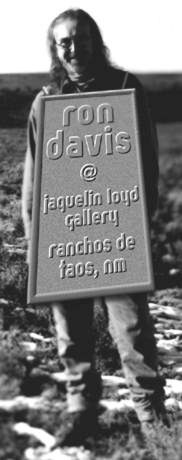

Abstract
illusionism and
the mind of Ron Davis
Artist's
work showing at the
Jaquelin Loyd Gallery in Ranchos
A
review by Joanne Forman
for The Taos News
"Painting? I wouldn't recommend it to a dog."
That's not Ron Davis' own opinion; he's quoting prominent
San Francisco(sic) [Los Angeles] painter Ed Moses.
The path for Davis to San Francisco and its famed art institute was a longish one. Born in Santa Monica, Calif., in 1937, he was reared in Wyoming, where he attended the University of Wyoming as an engineering student. He also worked as a sheet metal mechanic for a couple of years.
"Growing up in Wyoming," explains Davis, "I was completely unaware of serious painting. I was struggling . . . I'd done a few Sunday afternoon kinds of paintings." But like that other artist from Wyoming, Jackson Pollock, Davis was deeply affected by the big sky, the space of the West. And although he did spend a period at the Yale-Norfolk Summer School, he's a confirmed Westerner.
Davis continues yarning, for which he displays a decided talent: "I thought it would be great to go to Mexico, to the beach and paint and starve." However, his father sideswiped this romantic plan by agreeing to send him to art school. Via the one artist he knew at the time, he was aware of the San Francisco Art Institute, and there he went, to plunge into the heady and immensely yeasty world of the 1960s.
There he met Nicholas Wilder, who opened a gallery on La Cienega (gallery row) in Los Angeles. Davis also had a show at the Leo Castelli Gallery in New York City, and that's when the museums began to notice his work. Davis' work is now in the Los Angeles County Museum, Museum of Modern Art in New York City, Tate Gallery in London, the Art Institute in Chicago, Corcoran Gallery in Washington, D.C., and the Wallraff-Richartz Museum in Cologne, Germany – among many others.
After living in Malibu for 16-some years, Davis got tired of the mud slides and the traffic. "I was burnt out," he said succinctly. A friend had moved to Arroyo Hondo and turned Davis on to the area. He came here in1990 and began building a complex of six living and studio buildings, based upon a Navajo hogan design. Collaborating with architect Dennis Holloway and anthropologist Charley Cambridge, he discovered the relationship between the hogan's corbeled dome and work Davis had conducted previously. He built a number of hogan frame "Spirit House" log sculptures and showed a model of the large Hondo hogan in Los Angeles in 1993.
When not painting, Davis does three-dimensional graphics and has his own internet Web site at www.abstract-art.com.
Davis' new series, "Wax Series: Encaustic on Wood," using beeswax and pigment on shaped wood constructions, continues his preoccupation with "painting as an illusion of an object," a style he calls "abstract illusionism." An exhibit of this work opened Friday (Jan. 23, 1997) at the attractive new Jaquelin Loyd Gallery in Ranchos Plaza.
Wax Series: 1996-1997
at Jaquelin Loyd Gallery